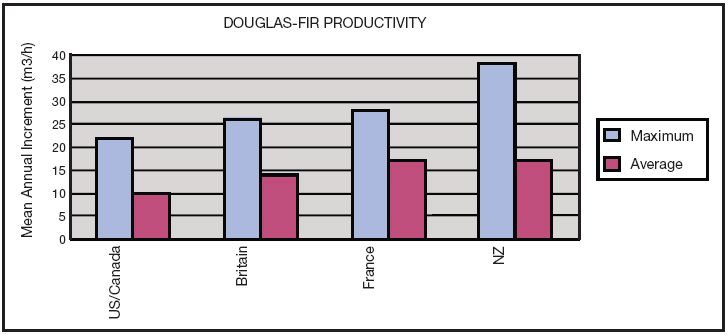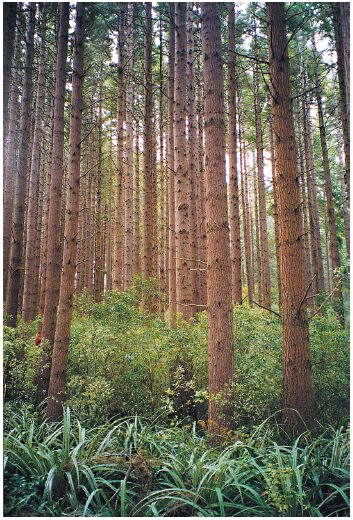Growing Douglas fir
NZFFA Information leaflet No. 19 (2005)
Attributes affecting objects of management
Douglas fir timber is used primarily for structural grades of timber; a premium is paid for timber with small knots and a high percentage of heartwood. Trees with very large knots are almost worthless, no matter how big they are.
Douglas fir should be grown at a close enough spacing to restrict branch size, and a square spacing is better at controlling branch size than a rectangular spacing.
Douglas fir is a moderate shade bearer, and stands can comfortably carry a basal area in the range of 80 to 100m2/ha.
Don’t thin too heavily, and aim to have a final crop of between 400 and 600 stems/ha which will restrict branch size and sapwood percentage. Better to concentrate on growing maximum volume per ha rather than large fast grown trees.
Provenance can have a major effect on branch size and stem straightness.
The best seedlots in NZ are the Beaumont strain, or imported seed from Fort Bragg or other recommended source. For good form trees, avoid Ashley seedlots or seedlots of unknown origin.
Timber cut from young or small trees is not noticeably inferior to that from mature trees.
If topography is not too steep, and access is good, always consider the possibility of having a regime which incorporates at least one production thinning.
Historically, little or no premium has been paid for clear timber in NZ.
It is unlikely that the cost of pruning could ever be recovered in the sale price. If a grower wants to cover the options, consider pruning the largest 100 trees/ha of good form. Provided they are the most vigorous, they are unlikely to suffer from competition from their unpruned neighbours, and they are the element that is most likely to downgrade timber value with large branches if left unpruned.

Siting requirements
Douglas fir is a moist climate species and does not tolerate drought well.
Only plant where the annual rainfall is above 1000 (preferably 1200) mm/annum, or if in the 800 to 1000mm/annum rainfall zone, plant only on cooler, sheltered sites where transpiration is less, or on deep moisture-retentive soils. Avoid drought-prone soils.
Douglas fir stocking and spacing for rainfall

Douglas fir is a cool climate species and does not tolerate high nighttime temperatures well, becoming stunted and with large nodal swellings distorting the grain.
Except in the south of the South Island, choose sites which are mainly southfacing and therefore cooler and likely to receive more rainfall. Avoid exposed northwest facing slopes and exposed ridges.
Douglas fir tolerates snow and cold winter temperatures well.
It is the species of choice on snow-prone sites and high altitude sites – up to 1000m altitude in northern South Island, and 600+m in further south.
Douglas fir is particularly intolerant of wet soils and out-of-season frosts, especially late spring frosts, and can suffer badly from salt burn.
Avoid planting wet soils, and flat sites on valley bottoms which are likely to be frost hollows; planting on these sites is usually a complete waste of time. Do not plant on exposed coastal sites.
Tree stocks
Establishment is likely to be quite variable unless tree stocks are uniform, vigorous and well conditioned.
It is difficult to condition containerised stock, so well-conditioned bare-rooted stock is best, especially on hard sites. Containerised stock grown on in the nursery as bare-rooted stock is likely to have good root systems and can be well conditioned.
The best measure of a tree’s vigour is the root collar diameter; the bigger the diameter the more food reserves for quick root growth after planting.
Ideally, the root collar diameter should be at least 10mm and trees need to be at least 2 years old to reach this size. To ensure uniformity in growth after planting, it is more cost effective, even if a premium is paid, to order trees at least a year in advance and insist that the root collar diameter of all seedlings is at least 10mm. Ordering trees at the last minute will almost guarantee that you will be supplied rubbish.
Establishment
Douglas fir is much more sensitive to mistreatment in handling and planting than radiata pine.
Always ensure that trees stocks receive the best handling practice – never leave the roots exposed to the air, transport seedlings on their side and never with their tops exposed, store in a cool and shady place, and employ quality planters.
Douglas fir responds well to good site preparation.
Ideally, the ground should be cultivated at depth with a winged ripper, but failing that, planters should cultivate the planting spot before planting rather than planting in a single spade slot. A trial at Golden Downs forest many years ago showed that on deep cultivated soil with good weed control and high quality stock, growth over the first 3 to 4 years was faster than that of radiata. Roots should be well trimmed to avoid tangling or distortion, and seedlings should be planted deeply to ensure wind firmness and best access to moist soil.
Douglas fir responds well to good weed control, and is slow to dominate woody weeds.
If woody weeds are present, ensure that they are eliminated or well under control before planting, otherwise establishment is likely to be patchy. With gorse or broom, they should be cleared early in the growing season, and seedling regrowth killed by spraying in the autumn before planting. Eliminating grass competition is essential, especially if rainfall is marginal.
Douglas fir does not respond well to fertiliser in the early years unless the site is impoverished.
There is usually little point in applying fertiliser at the time of, or soon after planting. Where boron is likely to be marginal, an early application will minimise sinuous distortion of the leaders.

Douglas fir is very susceptible to hare damage, especially immediately after planting.
Where possible, ensure that good hare control is carried out before planting, and if necessary, use an animal repellent immediately after planting. Contrary to appearances, Douglas fir is not particularly palatable to sheep, and light grazing to control grass can often be used after two or three years, but always watch stock carefully when first introducing them.
Initial stocking
To ensure good branch control, a minimum of 1000 effective stems/ha is required. Because planting stock is often variable, it has been usual to plant at least 1200/ha, and up to 1600/ha if the site is hard or preparation is poor, to achieve this effective stocking. Provided high-quality uniform stock is used and site preparation is very good, planting at 3 x 3m (1110/ha) is adequate, but spacings of 3 x 2.5 (1330/ha) or 2.5 x 2.5 (1600/ha) should be used under more difficult conditions.
Thinning
Stands left unthinned will probably require a rotation of about 60 years before a majority of living trees are large enough to harvest. Unthinned stands have the maximum volume at maturity, and minimum knot size in the timber, but many stems will be of small diameter. If stands are thinned to waste to about 600 stems/ha at age 12 to 15, the rotation may be shortened to 45 to 50 years, and average tree size at harvest will be larger, but branch size in the upper logs will also be larger. Delaying thinning to about age 25 and thinning to 400 to 500 stems/ha will push the rotation up to over 50 years, but the thinnings will be merchantable. The rotation can be reduced to about 40 years by thinning to waste to about 800/ha at age 10, and production thinning to about 400 stems/ha at age 20.
Photograph reproduced from the May 2000 issue of the New Zealand Tree Grower.

 Farm Forestry New Zealand
Farm Forestry New Zealand